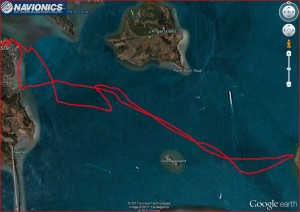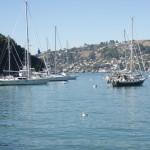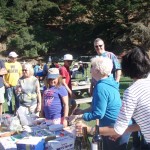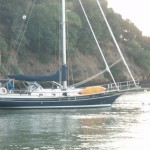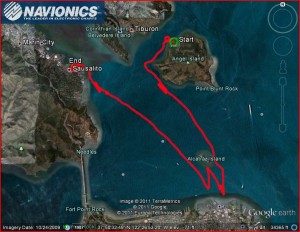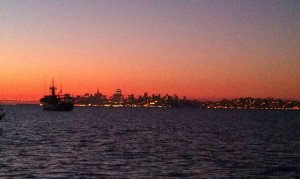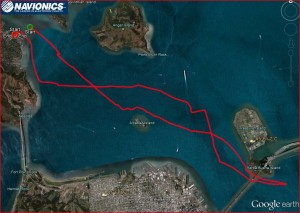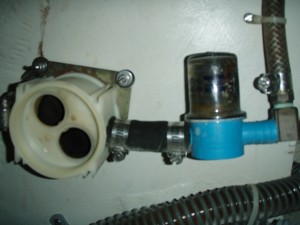After arriving in Sausalito late Thursday afternoon, we mostly played for two days in Sausalito, including a lovely night with some dockmates at the Cavallo Point bar (leather seats, sophisticated atmosphere) and the Presidio Yacht Club bar (stripper poles, hamburgers and a live band!). We did get several good hours of work in on Cool Change on Saturday: Rick pulled lead wire through the boat for the windlass and for 12-volt receptacles at the helm, and Cindy restored about 2/3rds the interior teak – both very satisfying accomplishments. We finally got out on the bay on Sunday. There wasn’t much wind but we did our best, using our motor to supplement the wind. Below is our route. We had to double back on ourselves just as we got out into the slot into some wind, due to an outgoing oil tanker, so we didn’t get very far – just out around Alcatraz and back home. Our highlight of the day was returning to dock. It was slack tide by then, and there was no wind, so we decided it was perfect conditions to try our luck at backing into our slip. It took each of us a couple of times to line it up right, but in the end, we both successfully docked Cool Change by backing in to our slip. That is not an easy task with the type of rudder-keel combination we have, which is designed to keep the boat tracking, not turning, especially in reverse! But it is an important skill to have, not only because we’ll have to prove our ability to do so as part of our US Sailing coursework, but also, and more importantly, because there will be times while cruising where it will be necessary. For once, we got back to dock and got the boat and ourselves cleaned up and ready to drive home at a decent hour, arriving back home in the early evening.
-
Subscribe to our blog
A most excellent adventure
Blogroll
Useful or Interesting Links
Where we are now
Categories
- Anchoring Systems
- Back in the States
- Cindy’s posts
- Cruising Southern California
- Deck and exterior maintenance
- Dinghy and Outboard Motor
- Electrical system
- Electrical system
- Electronics
- Engine
- Interior Cabin, Galley, Head
- Land Yacht 2021
- Living the Dream – Our Trip has Begun
- Maintenance and Enhancements
- Maintenance Expenses
- Plumbing
- Preparation Details
- Ricks thoughts so far.
- River running
- Sailing and Living in Mexico
- Sailing Northern California
- Sailing the Seven Seas
- Sailing the South Pacific
- Sails and Rigging
- Sausalito
- Uncategorized
Archives
- September 2023 (1)
- June 2023 (1)
- May 2023 (1)
- December 2022 (1)
- October 2022 (1)
- September 2022 (2)
- August 2022 (3)
- July 2022 (4)
- February 2022 (1)
- December 2021 (1)
- November 2021 (4)
- October 2021 (5)
- September 2021 (3)
- August 2021 (5)
- July 2021 (4)
- June 2021 (4)
- November 2019 (2)
- August 2019 (1)
- July 2019 (1)
- June 2019 (1)
- April 2019 (1)
- March 2019 (1)
- November 2018 (1)
- October 2018 (1)
- September 2018 (1)
- August 2018 (1)
- July 2018 (4)
- March 2018 (1)
- January 2018 (1)
- November 2017 (1)
- August 2017 (1)
- July 2017 (1)
- May 2017 (3)
- April 2017 (1)
- March 2017 (1)
- February 2017 (1)
- January 2017 (4)
- December 2016 (1)
- July 2016 (1)
- May 2016 (3)
- March 2016 (2)
- February 2016 (4)
- January 2016 (1)
- December 2015 (3)
- November 2015 (1)
- October 2015 (3)
- September 2015 (2)
- July 2015 (2)
- April 2015 (2)
- March 2015 (3)
- February 2015 (2)
- January 2015 (4)
- December 2014 (4)
- November 2014 (2)
- October 2014 (4)
- September 2014 (10)
- August 2014 (6)
- June 2014 (1)
- February 2014 (5)
- December 2013 (1)
- November 2013 (4)
- September 2013 (4)
- June 2013 (4)
- May 2013 (13)
- February 2013 (2)
- January 2013 (1)
- December 2012 (2)
- September 2012 (3)
- July 2012 (2)
- June 2012 (3)
- May 2012 (7)
- February 2012 (3)
- December 2011 (3)
- November 2011 (3)
- October 2011 (9)

